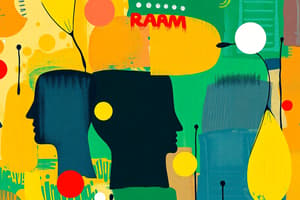Podcast
Questions and Answers
Which action exemplifies strategic HRM during a health crisis like the COVID-19 pandemic?
Which action exemplifies strategic HRM during a health crisis like the COVID-19 pandemic?
- Ignoring employee stress to focus on productivity.
- Focusing solely on redundancies without considering remote work options.
- Maintaining traditional operational procedures without modifications.
- Implementing flexible organizational structures to protect employees. (correct)
How has Industry 4.0 influenced human resource management practices?
How has Industry 4.0 influenced human resource management practices?
- By reducing the importance of human resource planning.
- By decreasing the need for e-HRM systems.
- By increasing the use of artificial intelligence. (correct)
- By increasing reliance on traditional administrative tasks.
What is a key characteristic of the knowledge economy that presents strategic challenges for HRM?
What is a key characteristic of the knowledge economy that presents strategic challenges for HRM?
- A reduction in the need for stakeholder engagement.
- A decrease in unemployment rates.
- A focus on tangible means of production.
- An emphasis on the availability and quality of information. (correct)
Which demographic change poses a strategic challenge for HRM related to an aging workforce?
Which demographic change poses a strategic challenge for HRM related to an aging workforce?
How does the change in legislation and new forms of employment impact the strategic role of HRM?
How does the change in legislation and new forms of employment impact the strategic role of HRM?
What is the main focus of Society 5.0 regarding its impact on human resource management?
What is the main focus of Society 5.0 regarding its impact on human resource management?
How does the changing nature of HRM affect organizational structures?
How does the changing nature of HRM affect organizational structures?
Which theoretical approach to strategic human resource management emphasizes matching human resource practices to the overall organizational strategy?
Which theoretical approach to strategic human resource management emphasizes matching human resource practices to the overall organizational strategy?
What does the resource-based approach to HRM emphasize in achieving organizational success?
What does the resource-based approach to HRM emphasize in achieving organizational success?
How does the configuration approach view the implementation of HRM practices?
How does the configuration approach view the implementation of HRM practices?
What strategic challenge does the increase in the number of immigrants pose for HRM?
What strategic challenge does the increase in the number of immigrants pose for HRM?
Which of the following practices does NOT align with the concept of strategic HRM during a pandemic?
Which of the following practices does NOT align with the concept of strategic HRM during a pandemic?
In what way can human resource management assist in strategic challenges caused by the development of a knowledge economy?
In what way can human resource management assist in strategic challenges caused by the development of a knowledge economy?
How can flexible work practices implemented by HRM address the challenges posed by changes in legislation?
How can flexible work practices implemented by HRM address the challenges posed by changes in legislation?
How can technology and automation impact the role of HRM in Society 5.0?
How can technology and automation impact the role of HRM in Society 5.0?
How does the change in organizational structure affect the performance tasks of employees?
How does the change in organizational structure affect the performance tasks of employees?
How does a configuration approach of HRM showcase external fit?
How does a configuration approach of HRM showcase external fit?
The global pandemic caused by the outbreak of the COVID-19 virus harmed certain economic sectors, disabling the normal operation of organizations. How did organizations adjust?
The global pandemic caused by the outbreak of the COVID-19 virus harmed certain economic sectors, disabling the normal operation of organizations. How did organizations adjust?
Why is Industry 4.0 widely known?
Why is Industry 4.0 widely known?
In what ways are organizational structures changing?
In what ways are organizational structures changing?
Flashcards
Strategic HRM
Strategic HRM
Strategic HRM involves formulating and executing HR policies that produce the employee competencies and behaviors needed to achieve strategic aims.
HR Challenges: Health Crises
HR Challenges: Health Crises
Significant implications for the human resource caused by health crises (e.g., COVID-19), including redesigning operations and ensuring safe work environments.
HR Challenges: Industry 4.0
HR Challenges: Industry 4.0
Strategic challenges result from the Fourth Industrial Revolution (Industry 4.0): dominance of e-HRM, AI, big data, flexible rewards, etc.
HR Challenges: Knowledge Economy
HR Challenges: Knowledge Economy
Signup and view all the flashcards
HR Challenges: Demographic shift
HR Challenges: Demographic shift
Signup and view all the flashcards
HR Challenges: Legislation
HR Challenges: Legislation
Signup and view all the flashcards
HR Challenges: Society 5.0
HR Challenges: Society 5.0
Signup and view all the flashcards
Changing Nature of HRM
Changing Nature of HRM
Signup and view all the flashcards
Universalist Approach
Universalist Approach
Signup and view all the flashcards
Strategic Best-Fit Approach
Strategic Best-Fit Approach
Signup and view all the flashcards
Resource-Based Approach
Resource-Based Approach
Signup and view all the flashcards
Configuration Approach
Configuration Approach
Signup and view all the flashcards
Study Notes
- Strategic HRM involves formulating and executing HR policies and practices that cultivate employee competencies and behaviors.
- These competencies and behaviors are necessary to meet the company's strategic aims.
Contemporary Trends in HRM
- Several contemporary trends hold significance for human resources.
- Health crises, especially the COVID-19 pandemic, are a trend.
- The COVID-19 pandemic harmed various economic sectors and disrupted organizational operations in the first half of 2020.
- Organizations adapted with flexible structures and employee protection measures.
- HRM strategic challenges during the pandemic included redesigning operations and regrouping business units.
- Also, challenges included changing organizational structure, efficient decision-making, safe work environments, and remote work.
- Other challenges were employee stress management, redundancies, reduced salaries, and flexible work hours.
- Technological change and the dominance of Industry 4.0 is another trend.
- The German government introduced the term Industry 4.0 in 2011 via the "High Technology Strategy."
- Industry 4.0, an abbreviation for the Fourth Industrial Revolution, emphasizes connectivity.
- It integrates intelligent digital technologies into manufacturing and industrial processes.
- Strategic challenges for HRM due to Industry 4.0 include e-HRM dominance and increased HR efficiency.
- Also, reducing administrative burdens, facilitating HR planning, and adapting organizational design are challenges.
- Furthermore, the use of AI, automating recruitment, evaluating performance through Big Data are challenges.
- Industry 4.0 affects cafeteria-benefit plans and flexible rewards.
- Economic Change and the Knowledge Economy is another trend.
- The knowledge economy values information (quality, quantity, accessibility or intellectual capital) over production.
- HRM faces challenges from the knowledge economy's development, including slowed economic growth.
- Also, there are challenges from COVID-19, increased unemployment, changing economic structures and employment forms.
- The impact of the knowledge economy has challenges for meeting stakeholder needs and increasing product quality.
- Demographic Change and Increasing Immigration is a trend.
- Demographic shifts are more evident in developed countries in the 21st century.
- Diversification is rising within the working-age population, promoting equal employment.
- HRM strategic challenges from these demographic shifts include prolonged seniority and equal pay.
- Additionally, challenges include balancing work and life, tackling unemployment, and flexible arrangements.
- Change in Legislation and New Employment Forms is a trend.
- A significant challenge is complying with strict legal regulations governing employer-employee relations.
- Legislative changes target groups often facing vilification.
- HRM faces new employment challenges, including flexible work, employing people with disabilities and national minorities.
- Challenges also include preferences for war veterans, remote work, and zero tolerance towards vilification.
- Social Change and Society 5.0 is a trend.
- In 2016, Japan introduced Society 5.0, driven by technological innovation, with "The 5th Science and Technology Basic Plan".
- Society 5.0 envisions a super-smart society, profoundly changing people's habits, with realization expected in the 21st century.
- Society 5.0's HRM challenges include i-HRM (intelligent HRM) emergence and cognitive computing (AI) inclusion.
- Also, talent management development, continuous organizational and IT skill development are HRM challenges.
- Additionally, full digitalization and attentiveness to employee feelings are challenges for HRM.
Summarizing Strategic Challenges
- There are six strategic challenges for human resource management.
- These challenges have influenced changes in the HR role, giving it new significance.
- New roles in HR are an increasingly important research area.
Changing Nature of HRM
- According to Noe, Hollenback, Gerhart, and Wright, employees are becoming more energetic.
- Employees become more energetic in tasks they supervise and improve.
- Organizational structures are becoming flatter.
- People are participating directly in decision-making.
- Improvements are recognized and rewarded, emphasizing a team approach to problem-solving.
Theoretical Approaches to Strategic HRM
- Universalist: Asserts one best way to manage human resources.
- HRM involves transforming traditional practices into a limited set of "correct" procedures and policies.
- Strategic Best-Fit: Implies that HRM involves matching specific HR practices to the overall organizational strategy.
- Resource-Based: Suggests HRM drives organizational success by enhancing organizational capabilities.
- This involves acquiring, developing, utilizing, and retaining highly competent employees.
- Configuration: Recommends HRM configuration show external fit and match the business strategy and internal fit.
- HRM practices, or bundles, improve organizational performance when appropriately configured.
- Certain bundles suit specific industries or business conditions, while others serve different contexts.
Studying That Suits You
Use AI to generate personalized quizzes and flashcards to suit your learning preferences.




